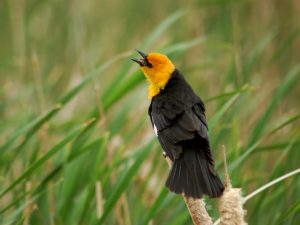If the 2019-2020 One Book, One Chicago selection The Sixth Extinction by Elizabeth Kolbert has sparked your interest in the environment, climate change and endangered species/extinctions, you may be surprised to learn that there are many resources in Illinois government documents that can further your exploration of these topics. Illinois has several state departments and agencies that focus on the states' environment, ecology, geology and natural resources.
For instance, the Illinois Environmental Protection Agency enforces laws and regulations that are meant to limit pollution and protect the air, water and land. The Illinois Natural History Survey monitors the biodiversity and ecology of the state and publishes scientific research. The Illinois Department of Natural Resources manages the state parks, forests and trails, fish and wildlife areas and recreational sites, and issues permits, among other things. The following are some examples of their publications that deal with the sorts of topics covered by The Sixth Extinction.
The brochure Endangered Species of Illinois discusses what species are threatened or endangered within the state and/or in the entire United States, and ones that have recovered from near-extinction. For example, the yellow-headed blackbird is endangered within Illinois, but not in the United States as a whole. This is mainly due to loss of habitat: Illinois has lost over 90% of its natural wetlands. We've also lost 80% of our forests and 99% of our original prairie. The Illinois DNR keeps a list of endangered and threatened species in Illinois.
What can we do about this enormous loss of habitat? Creating Habitats and Homes for Illinois Wildlife has some ideas, along with gorgeous color photographs. Because approximately 95% of Illinois' land is privately owned by farms, corporations, schools, religious institutions, small businesses, homeowners, etc., the Illinois DNR created this book to educate people on how to manage their land in ways that lessen the effects of habitat destruction and create wildlife-friendly areas. For those of us who live in cities, there are still things we can do with small yards and surrounding areas. For instance, we can increase the biodiversity by planting a wide variety of trees and shrubs, especially native species, which will provide shelter and food for many different animals. Avoid pesticides and non-native species, especially ones that have become invasive, such as Tartarian honeysuckle. Consider installing a few different types of bird feeders and nesting boxes. For more help, the Illinois DNR's Acres for Wildlife program can provide you with resources and guidance in how best to make your land more hospitable to wildlife.
Finally, if you're interested in more technical/scientific information about Illinois ecology, the book Canaries in the Catbird Seat is a great place to start. It celebrates the Illinois Department of Natural History's then-150 years of work, and includes chapters on Illinois geological history, methods of detecting biological change, different habitats and ecosystems of the state, restoration projects and more.





Add a comment to: Learn More about Illinois Ecology with State Resources